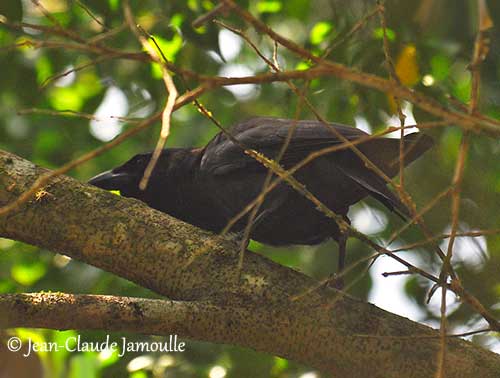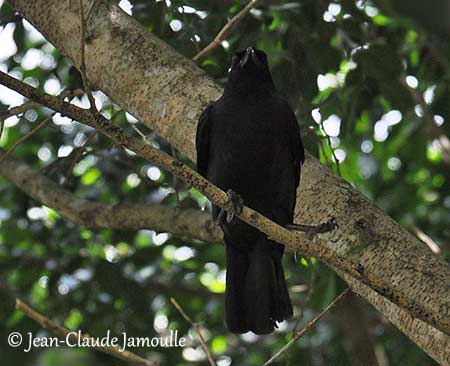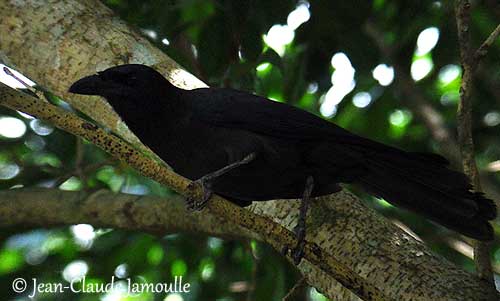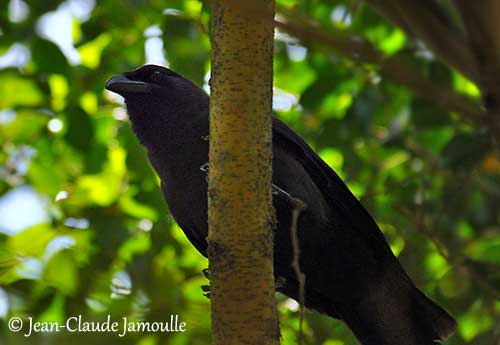
Fr: Corneille de la Jamaïque
Ang: Jamaican Crow
All: Jamaikakrähe
Esp: Cuervo Jamaicano
Ita: Corvo della Giamaica
Nd: Jamaicaanse Kraai
Sd: jamaicakråka
Photographer:
Jean-Claude Jamoulle
A la rencontre des Oiseaux
Text by Nicole Bouglouan
Sources:
HANDBOOK OF THE BIRDS OF THE WORLD Vol 14 by Josep del Hoyo-Andrew Elliot-David Christie - Lynx Edicions – ISBN: 9788496553507
CROWS AND JAYS by Steve Madge – Ed. Christopher Helm – ISBN: 0713652071
BIRDS OF THE WEST INDIES – by Herbert Raffaele, Kristin Williams et Tracy Pedersen – Helm – ISBN: 9780713649055
A Photographic Guide to the Birds of Jamaica by Ann Haynes-Sutton, Yves-Jacques Rey-Millet, Audrey Downer, Robert Sutton – Editor: Bloomsbury Publishing, 2010. ISBN: 1408133229, 9781408133224 - 336 pages
Food and feeding behavior of the Jamaican Crow
Communal roosting of the Jamaican Crow
Distribution, Abundance, and Conservation Status of the Jamaican Crow
Wikipedia, the free encyclopaedia
Jamaican Crow
Corvus jamaicensis
Passeriformes Order – Corvidae Family
INTRODUCTION:
The Jamaican Crow is endemic to Jamaica where it frequents undisturbed wet limestone forests at mid-elevations and woodland mixed with open areas.
It feeds primarily on a variety of fruits, berries, and arthropods. It typically takes both eggs and chicks in the nests of small passerines. It is usually observed in pairs or small groups while feeding high in trees.
The Jamaican Crow has restricted range and is vulnerable to extensive deforestation, but the species is not currently globally threatened.
DESCRIPITON OF THE BIRD:
Biometrics:
Length: 35-38 cm
Weight: 335-340 g
The Jamaican Crow is smaller and duller than other Caribbean crows.
It has dull black to dark brownish-grey plumage, with loose and soft texture.
Face, forecrown and throat appear usually darker. Wings and tail are darker grey with some slight gloss.
On the head, the nasal bristles are short and sparse, involving more or less exposed nostrils. We can see a patch of bare skin behind the eye and at bill base.
The stout bill is slate-grey, relatively long and deep-based. The eyes are grey-brown to reddish-brown (probably depending on the age). Legs and feet are black.

Male and female are similar, although the female is slightly smaller than male.
The juvenile is not described, but it has probably duller wings and tail.
RANGE:
The Jamaican Crow is endemic to Jamaica where it is more often observed in Cockpit Country and John Crow Mountains. But it is currently expanding its range.
HABITAT:
The Jamaican Crow frequents a variety of forests and woodlands, mountain pastures, wooded hills and open areas with agriculture and large gardens. During the dry season, it usually moves to lower levels.
CALLS AND SONGS: SOUNDS BY XENO-CANTO
The Jamaican Crow has a large repertoire of sounds, usually uttered in series of varied garbled outbursts. The most typical call is a harsh “craa-craa” but the usual vocalisation is described as a “garbled jabbering” and used at social gathering. The crow-like call “craa-craa” is probably mostly a territorial call given during the breeding season.
BEHAVIOUR IN THE WILD:
The Jamaican Crow is primarily arboreal. It feeds on a variety of fruits and berries by probing into bromeliads, loose underneath bark and rotten wood. Invertebrates are caught in similar way.
The visited trees are Ficus trigonata, Laetia thamnia, Cedrela odorata and Samanea saman, and probably others.

This species probes and pecks into rotten limbs in woodpecker-like fashion, indicating that it has flexible and diverse foraging pattern. However, like most Corvidae, it also takes eggs and nestlings in nests of small bird species.
The Jamaican Crow uses communal roosts in clusters of tall trees, arriving after sunset and leaving the roost before sunrise. They roost on tiny branches high in tree canopy.
Little is known on the breeding habits of this species, but it is presumed to breed solitary like most members of genus Corvus.
The Jamaican Crow is sedentary and territorial during the breeding season. It can be seen wandering in small groups outside of this period.
As an arboreal species, it has shorter wings, involving more laboured flight with frequent wingbeats.
The flight action is slow and heavy with active wingbeats. However, it is able to chase birds of prey through the trees.

REPRODUCTION OF THIS SPECIES:
The breeding season takes place from April to June.
The Jamaican Crow is probably monogamous and solitary nester within its territory. It nests high in tall tree where it builds a platform with sticks and other plant material. But it may also nest in tree holes.
The female lays three pale eggs (greenish-blue, greenish-white or yellowish-green) with dark markings.
No more information.
PROTECTION / THREATS / STATUS:
The Jamaican Crow has restricted range in which it is described as “fairly common”.
It is vulnerable to heavy deforestation, but the population is suspected to be increasing as this species is expanding its range on the island.
The Jamaican Crow is not globally threatened and currently evaluated as Least Concern.
